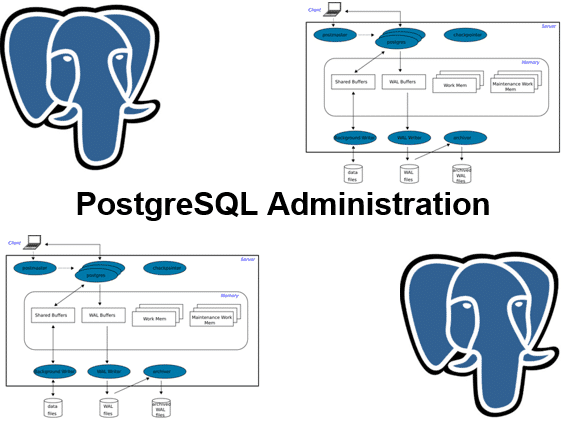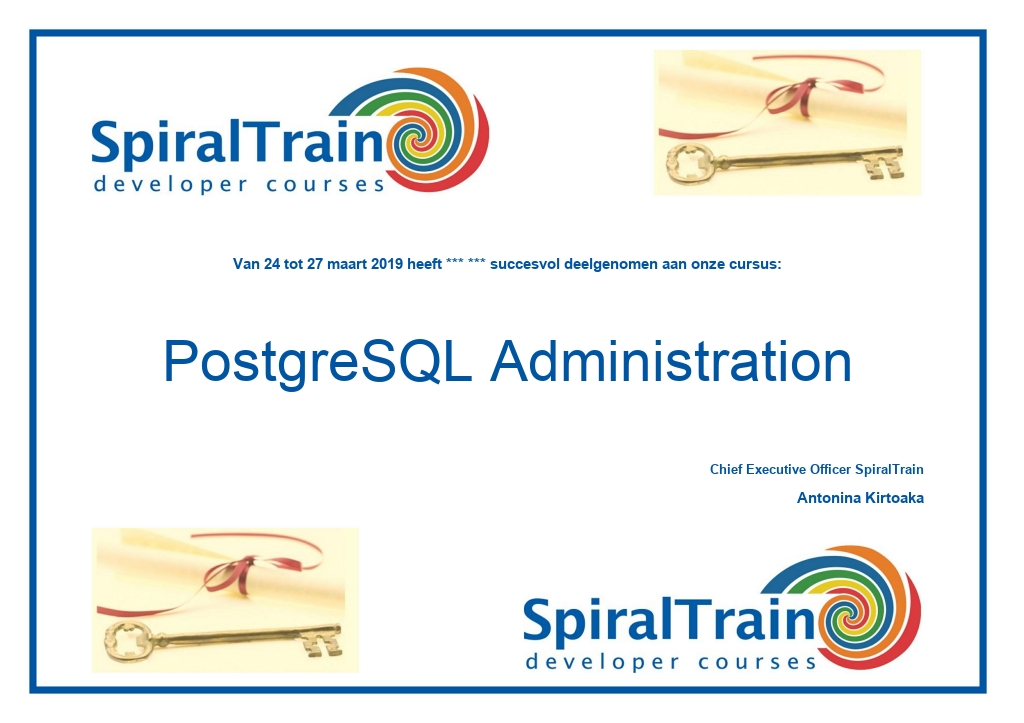- Leren door doen
- Trainers met praktijkervaring
- Klassikale trainingen
- Gedetailleerd cursusmateriaal
- Duidelijke inhoudsbeschrijving
- Maatwerk inhoud mogelijk
- Trainingen die doorgaan
- Kleine groepen
In de cursus PostgreSQL Administration leren de deelnemers PostgreSQL databases te configureren en beheren. PostgreSQL is a krachtig en robust open source object-relationeel database system met een goede reputatie wat betreft betrouwbaarheid en performance. In de cursus wordt gebruik gemaakt van de nieuwste versie van de PostgreSQL database en het pgAdmin grafische user interface.
De cursus PostgreSQL Administration gaat van start met een bespreking van de installatie opties en de tools pgAdmin and psql. Ook worden dan de voornaamste kenmerken van PostgreSQL behandeld zoals table inheritance, sophisticated locking, nested transactions en asynchrone replicatie.
Vervolgens wordt ingegaan op de PostgreSQL Architecture en de processen die daarbij een rol spelen zoals het Postmaster Daemon Process, Background en Backend Processen en Client Processen. En ook tablespaces en vacuum komen aan bod.
Eveneens wordt aandacht besteed aan de meest gebruikte server en database objecten die PostgreSQL levert. Het is van belang deze objecten, zoals o.a. Server Service en Database Object, te leren kennen om hun functionaliteit te kunnen benutten.
Dan is het tijd voor de PostgreSQL backup tools pg_dump and pg_dumpall. Point-in-Time Database Restoration en Setting up WAL archiving passeren dan de revue.
Het gebruik van indices in PostgreSQL en de verschillen tussen de indices B-Tree, Hash, GiSY, GIN and BRIN is eveneens onderdeel van de cursus PostgreSQL Administration.
Het beveiligen van een PostgreSQL Server is vanzelfsprekend van groot belang. In dat verband wordt ingegaan op access permissions en client authentication control, maar ook op Data Encryption en de pg_crypto module.
Tenslotte wordt aandacht besteed aan High Availability and Load Balancing door meerderde PostgreSQL servers in een cluster te plaatsen.
De cursus PostgreSQL Administration is bedoeld voor personen die PostgreSQL databases en PostgreSQL servers moeten beheren, controleren en ondersteunen.
Voor deelname aan de cursus PostgreSQL Administration is kennis van de SQL query taal en databases een vereiste.
De stof wordt behandeld aan de hand van presentaties. Demo's verduidelijken de theorie en praktische oefeningen zorgen voor een verwerking van de stof. De cursustijden zijn van 9.30 tot 16.30.
De deelnemers krijgen na het goed doorlopen van de cursus een officieel certificaat PostgreSQL Administration.

Module 1 : PostgreSQL Intro |
Module 2 : PostgreSQL Architecture |
Module 3 : Server and Database Objects |
|
What is PostgreSQL? PostgreSQL Features User-defined types Table inheritance Sophisticated locking mechanism Foreign key referential integrity Nested Transactions and Savepoints Multi-version Concurrency Control Asynchronous replication Install and Connect to PostgreSQL pgAdmin Application and psql Shell |
Shared Memory Shared and WAL Buffer PostgreSQL Process Types Postmaster Daemon Process Background Processes Backend Processes Client Processes Database Structure Create User Database What are Tablespaces? What is Vacuum? |
Server Service Database Object Table Object and Schema PostgreSQL Tablespaces pg_default and pg_global View as Virtual Tables Functions and Operators Server Configuration Logging Parameters Memory Parameters WAL Parameters |
Module 4 : Backup and Restore |
Module 5 : Indexes |
Module 6 : Database Management |
|
PostgreSQL Backup Tools pg_dump and pg_dumpall Point-in-Time Database Restoration Setting up WAL archiving Data and/or Structure pg_dump Parameters Backup Object Definitions pg_restore and psql Ignore and Stop on Errors pg_store Parameters Restore only Structure |
What are Indexes? Index Types B-Tree, Hash, GiSY GIN and BRIN Index Differences Create and Drop Index List indexes Unique Index Index on Expression Partial index and Reindex Multicolumn Indexes |
Options to Create Databases Modify Databases Rename Databases Change Owner and Tablespace Change Session Defaults Delete Databases Check Activity with pg_stat_activity Copy a Database Using pg_dump Get Database Object Sizes Using pg_size_pretty |
Module 7 : Role Management |
Module 8 : Securing PostgreSQL |
Module 9 : Cluster Management |
|
Access Permissions pg_hba.conf file Creating PostgreSQL Roles Privileges and Restrictions superuser Login Privilege pg_roles System Catalog Role Attributes Groups Role Membership User Role and Group Inheritance |
Client Authentication Control Rule Specification Server Configuration Changing Parameters Role Strategies Super User Management Data Encryption One and Two Way Encryption pg_crypto Logging pg_stat_statements Module |
High Availability Cluster Performing Replication Primary Server Promoting Standby Server Load Balancing HAProxy Configuration Xinetd Setup HAProxy in ClusterControl Reslaving Standby Server Chained Replication Keepalived |
